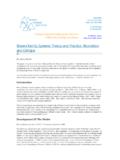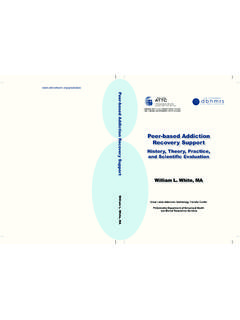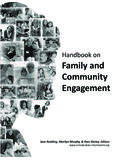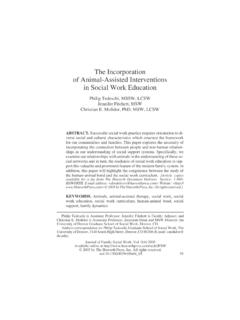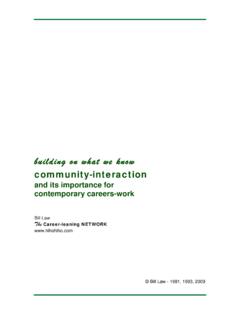Transcription of Learning from Complexity Theory: Is Strategic Planning ...
1 Learning from Complexity theory : Is Strategic Planning Obsolete? During the last few years, twentieth century scientific thinking has been creating ripples and raising ques- tions in the business world. These ripples, in the form of Complexity theory (which includes chaos theory ). have challenged the notions of scientific management, including Strategic Planning . Complexity theory sug- gests that a predictable, orderly universe is over, and with it Strategic Planning . Scientific management, as a discipline, began with theorists like Taylor and managers like Fayol who saw Strategic Planning as predict- ing the future, setting goals, and describing how to get there. This orderly process corresponded to New- ton's laws in which he applied the principle of gravity and laws of motion to predict an orderly and controlled universe.
2 In both, the ability to predict and control the future is paramount. In today's world, the ability to do either is impossible. Trained originally as a biologist, I believe that fundamental laws governing natural and human systems have practical and important significance for family business consultants. In this paper, I will discuss com- plexity theory and explore its application to our work and its relevance to Strategic Planning . My conclu- sion is that Strategic plans are not obsolete if they are dynamic and reflect an adaptive readiness to whatever the future may bring, a readiness that requires the capabilities of building connections and com- petencies, encouraging systemic rather than reductionistic thinking, and stimulating quick responses to events as they unfold. What is Complexity theory ? Complexity theory , a way of understanding complex systems, is complicated and includes chaos theory .
3 Unfortunately, its puzzling terminology has discouraged some from tackling its exciting and useful con- cepts. It has evolved from studies in physics, mathematics, computer sciences, and biology. One helpful way to conceptualize Complexity theory is, as Kevin Kelly, author of New Rules for the New Economy, says, to think nature. Another is captured in this adage: You can't make a plant grow. (You can, however, provide the necessary ingredients for optimal growth, but, even then, it may not thrive, for who knows what the weather, or other random events, will be?). Complex systems are non-linear. Non-linear dynamics refers to systems whose change is not in a straight line, is disorderly. Input is not necessarily proportional to output. Huge events can have negligible effect and small events can have huge effects.
4 (This is referred to as 'sensitivity to initial conditions, also as the 'butterfly effect, as in, 'if a butterfly flaps its wings in Tokyo, will it cause a blizzard in New York?'). Complex systems are always considered in relation to the larger systems out side and the smaller (sub) sys- tems inside. They cannot be understood otherwise. As the system changes, it, in turn, changes the environ- ment. In neo-Darwinian fashion, both species and environment are in the process of adaptation and change in reaction to each other. The question is not nurture or nature but creative emergence as systems Complex systems are capable of self-organization, a creative process that usually occurs at the 'edge of chaos,' often around an attractor. (Attractors are like magnets in the complex systems they attract behav- ior cause it to be repeated.)
5 Chaos in the modern sense is not the same as disorder but a delicate balance between order and disorder. Real change occurs when attractors are changed, or when the system moves toward strange attractors which reveal an orderly pattern within the chaos. The most useful way to think of attractors is to imagine them as the family 's and business's core values. Copyright 1999-2002, The family Firm Institute, Inc. III. A / Practice Papers / 141. How does Complexity theory differ from General systems theory General systems theory includes both simple systems (for example a thermostat and furnace which is a closed feedback system ) and complex systems (the family ). Simple systems have little or no interaction with other systems and they change in a linear way predictable and in a straight line. Complex systems inter- act with other systems constantly and change is non-linear and unpredictable.
6 Complexity theory and gen- eral systems theory differ in several important respects: Homeostasis According to general systems theory , equilibrium is a desired state. Although family therapists have shifted toward increasing Complexity , most are still, however, convinced that stable, steady, homeosta- tic states are desirable. By contrast, Complexity theory holds that the real world has little to do with equilibrium. Equilibrium means death. The very essence of life is change and transformation. Change is all there is. Life is always poised for flight. From a distance it looks still .. but, up close, it is flit- ting this way and that, as if displaying to the world at every moment its perpetual readiness to take off in any of a 1000 directions. (The Beak of the Finch, Weiner). Entropy, in closed systems, is a dissipation of energy, and means decay and certain death.
7 In open sys- tems and Complexity theory , however, when the environment is included in the system , nothing is iso- lated. Therefore, the energy flow between the systems can lead to reorganization. Entropy can signal the beginning of a new life. Related to the notion of constant change are two other theories: Heisen- berg's Uncertainty Principle, that states that the act of measuring a system brings about change in it;. and the Hawthorne Effect, or the behavior and production changes in a group when it is aware that others are taking an interest in it. Boundaries In general systems theory , boundaries define units of systems; they are fixed in their structure, although the level permeability, or flow of information, can change. In complex systems, the bound- aries are continually changing and always permeable, with critical exchanges between the inside and out.
8 A desirable condition, 'bounded instability' is a state between rigidity and chaos, which readies a team or family for growth and creativity. (The Complexity Advantage, Kelly and Alison). Hierarchies General systems thinking considers hierarchies in terms of power, age, size, and formal position. The parents are at the top of the family hierarchy. Complexity redefines what those with formal authority should do: be role models as well as create the environments for possibilities in interactions, Learning and growth. In the Newtonian model an individual would remain inert until pushed, pulled, or other- wise moved. In the Complexity model, individuals grow and change continually, with or without bosses or parents. Practical Applications Time and Patience As advisors, we fail if we search for order too quickly or if we jump to solutions too fast.
9 We must under- stand that to enter a system means to change it. If we offer canned assessments or cook-book solutions, we will not get full 'buy-in' for change, nor will the changes last. 142 / III. A / Practice Papers Copyright 1999-2002, The family Firm Institute, Inc. Participative Leadership Those in positions at the top of a hierarchy do serve important functions. However, in family businesses, too often, we see a 'command and control' approach to leadership. We should help to improve the capabili- ties for collaborative decision-making and high functioning teams in families, the boards, family offices as well as businesses. The more the centralized thinking (older generations, owners, managers) is clear, sim- ple, understood, the more the decentralized thinking (younger generation, employees, work teams) is effi- cient and effective.
10 Collaborations, with parameters, increase speed, flexibility, creativity and resilience. In his book, Young Men and Fires, MacLean dramatically connects the failure of leadership, communication and process to the deaths of 13 men in the Mann Gulch fire of 1949, although the skills were there. Change Begets Change The family and the business, like Darwin's finches and the islands of the Galapagos that they inhabited, evolve in interaction with each other. Think of the changes that occur, either sudden growth or stagnation, and how this can affect a family , which can, in turn, affect the business, and vice versa. For example, a seri- ous family conflict can affect the market share of a family business which will affect the competition, which will, in turn, affect the family and so on. Cause and effect are intertwined.
